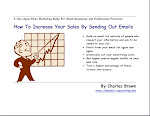The Difference Between Writing Web Content and Web Copywriting
Posted by Charles Brown at Wednesday, August 13, 2008What is the difference between writing web content and web copywriting?
There are two very different styles of writing that you may find on a web site. "Web content" refers to the purely informative text that you may read.
"Web copywriting," on the other hand, refers to the purely persuasive writing that is designed to get a reader to take action (usually to buy something, but sometimes to opt onto a list or subscribe to a newsletter, join a membership or schedule an appointment).
And as with just about everything else in life, there are gray areas between the two. Sometimes they will overlap and often you will see elements of both styles on a single web site.
Let's start by imagining why someone has come to your web site.
Chances are they did not come to be sold something. Except for entertainment and adult sites, most visitors go online to find out information (and since I don't deal with those two exceptions, I'll just talk about the information seekers here).
So we can safely assume that this person who is visiting your site has come to get answers to questions and/or solutions to problems. All of this means that you are a provider of information.
If you provide good information (ie content) to this visitor, you may later have the opportunity to persuade him or her to buy from you (via persuasive copywriting).
The reason for this is that providing good information is persuasive all by itself. Whey you answer questions and educate your visitor, that person will perceive you as an expert and a knowledgeable source. You also build up credibility and trust, which removes many of the objections and doubts a potential buyer might have about you.
On the other hand, some sites do very well with pure copywriting. For examples of this, visit Clickbank.com. Clickbank is a directory of digital products that refers you to one-page web sites that look and feel just like direct mail pieces.
Some of these pages are very well-written examples of pure web copywriting. They promote a single product and give you every reason in the world to buy it. These sites are not about providing information (although they often give you just enough information to arouse your curiosity), they are about selling a product.
And I would argue that there is nothing wrong with this. Many bigger companies that offer a variety of products or services might do well to have such sales pages (that look and feel a little like direct mail pieces) within their sites. After the site has provided lots of content and information, additional links can send visitors to a variety of sales pages to get visitors to take action.
A key to writing for a web site is to mix these two styles together. As you provide informative content, don't make it difficult for the person who suddenly decides to buy. Make sure your "Buy Now" links are clearly visible and have tabs that can lead them to other parts of your site without going back to the home page.
Within a single article you can write informative content and also give your visitors REASONS to take action or buy. You can paint pictures of a better tomorrow if they use your product, you can proactively answer objections and you can begin building agreement that certain solutions are the answers to their problems.
Writing web content and web copywriting are both arts and sciences. But they both begin with understanding who your visitors are and what they want.
COPYRIGHT © 2008, Charles Brown
Add to Onlywire

Labels: info products, writing website content



Charles,
An additional caveat to writing for the web, is the ever-increasing focus on writing search engine friendly web content. Unfortunately, Search Engines would prefer indexing pages that are completely unformatted and contain no pictures or multimedia like Flash. So, it's a struggle to maintain good content, copywriting, and search engine optimized content. I'd love to hear your comments on a post I wrote regarding this topic at http://matthewmamet.com/2007/09/20/amount-of-content-per-web-page/
Anonymous said...
6:15 PM